A subscriber recently asked me…
“Rayner, what’s the one indicator you can’t do without?”
Without a doubt, I replied, “Moving Average” (MA).
To be honest, I wasn’t a moving average trading strategy fan in my early years of trading. I had thoughts like…
“Indicators are useless because it’s lagging.”
“Indicators are for newbies.”
8 years later… I can tell you, I’m wrong.
The moving average is one of the most versatile trading indicators I’ve come across, and it can be used in different ways you never thought possible.
So, here’s what you’ll learn today:
Warning:
This isn’t a basic guide where you’ll learn the difference between simple, exponential, or weighted MA (you can google them yourself).
These are advanced moving average trading strategies that I’m using to trade the markets (and some of them you’ve probably not seen before).
Are you ready?
Let’s go.
How to use moving average to trade with the trend
I’m sure you’ll agree with me when I say that a downtrend consists of lower highs and lows, right?
But… sometimes you get a higher high in a downtrend, so does it mean the trend is over?
An example:

Rome was not built in a day, and no real movement of importance ends in one day or in one week. It takes time for it to run its logical course. – Jesse Livermore
Here’s the thing…
Just because you get lower high (and lower low) in an uptrend, doesn’t mean the trend is over.
It could be a complex pullback, before the resumption of the trend.
Here’s an example:
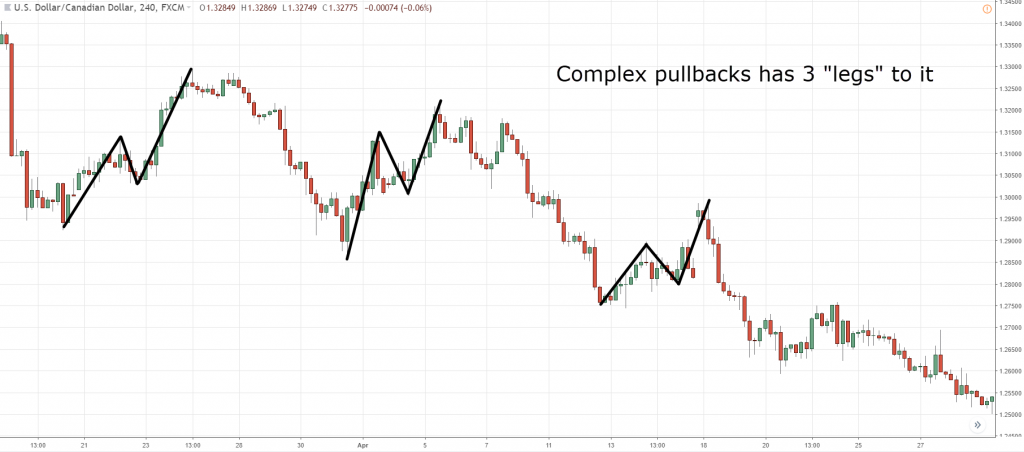
So, you’re probably thinking:
“How can I better define a trend objectively?”
Well, you could use the MA indicator to help you.
Here’s how to read moving average and use it to trade with the trend…
If the price is above the 200 EMA and 200 EMA is pointing higher, then the market is in a long-term uptrend (of your given timeframe).
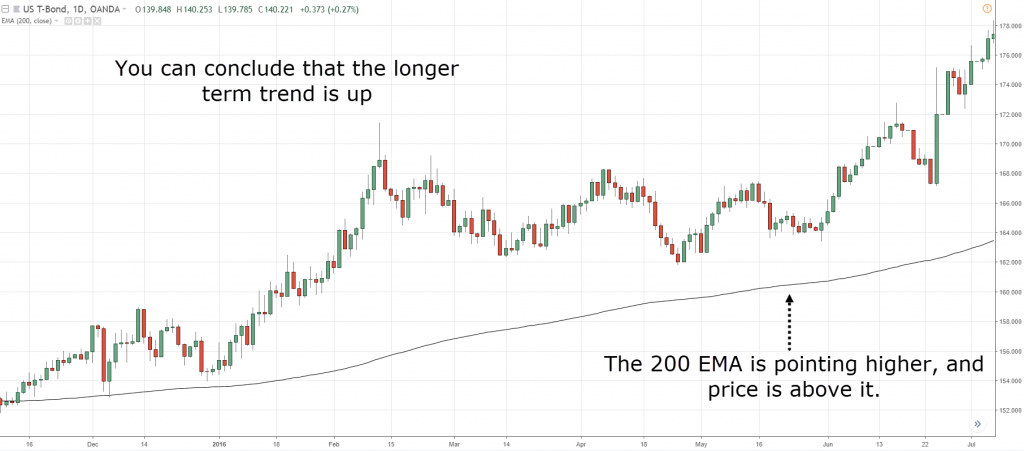
And… if the price is above the 20 EMA and 20 EMA is pointing higher, then the market is in a short-term uptrend (of your given timeframe).

Does it make sense?
Next…
You can gauge the strength of a trend by looking at the steepness of the MA.
The steeper the MA, the stronger the trend. And the flatter the MA, the weaker the trend.
Here’s what I mean:
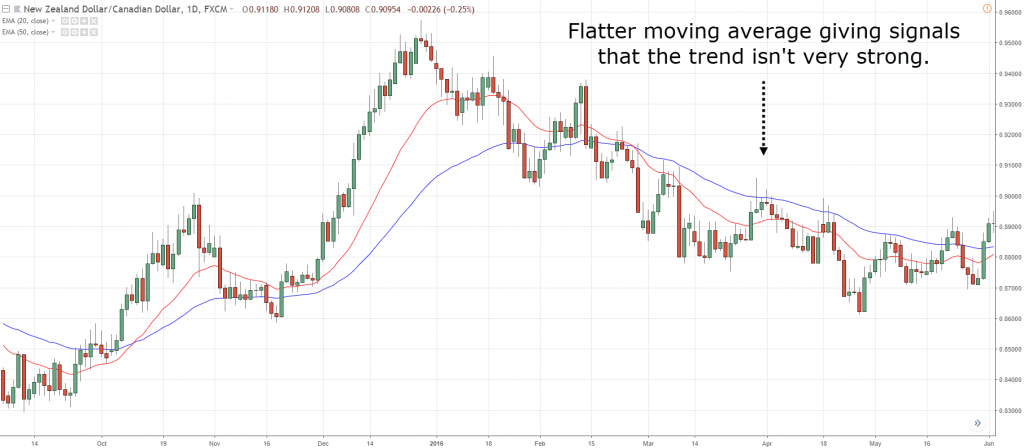

If you want to learn more, go watch this training video below:
How to use the moving average to identify value on your chart
You’ve probably heard the saying “buy low and sell high”.
But the question is… how do you define what’s low and high?
This is where the MA indicator can help.
Now, you’re wondering:
“Which MA should I use?”
Here’s the thing…
There’s no best MA out there.
Rather, you need to find something that’s aligned with your trading approach.
If you’re trying to trade long-term trends (on your given timeframe), then the 200 EMA would suit you.
If you’re trying to trade mid-term trends (on your given timeframe), then the 50 EMA would suit you.
Personally, I use the “space” between 20 & 50 EMA to define the area of value.
Here’s an example:
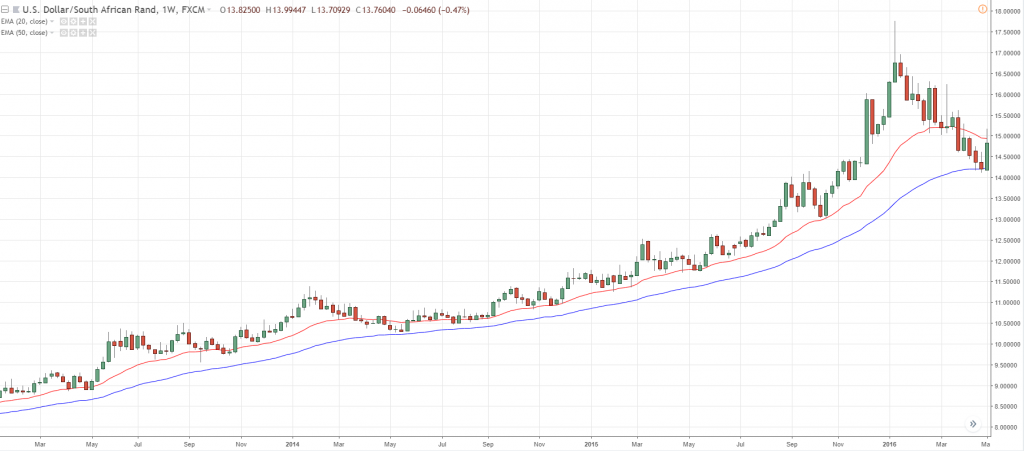
Pro tip:
MA works best in trending markets. Avoid using them in range markets.
How to use the moving average to set your stop loss
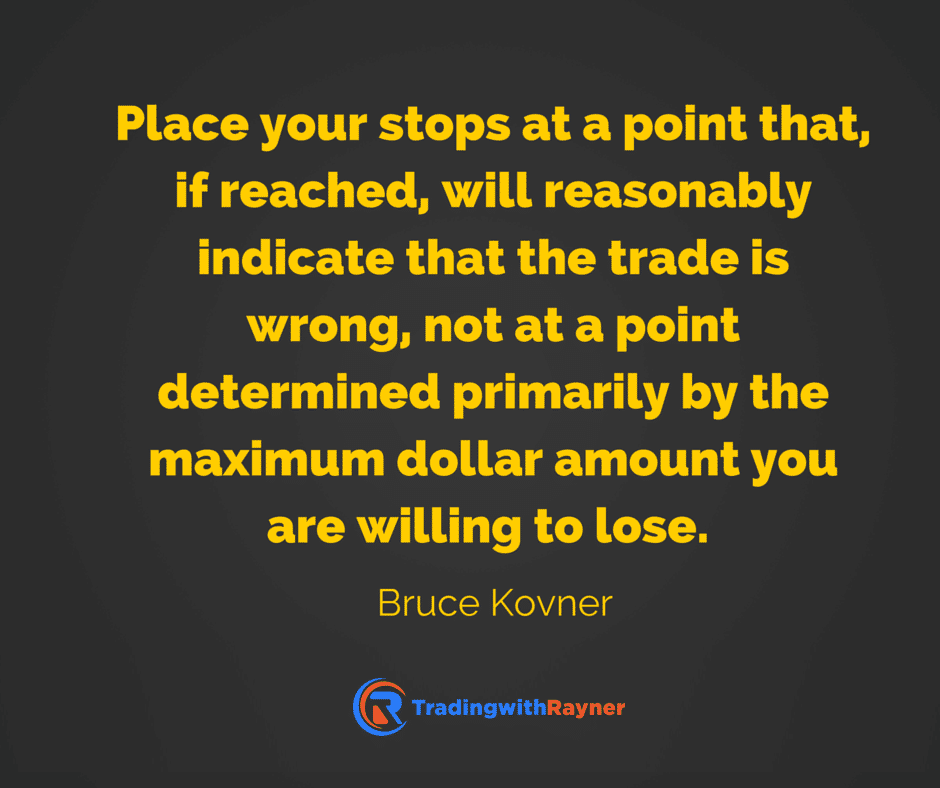
Another term you need to understand is dynamic Support & Resistance (SR).
These are areas of value on your chart that’s identified using MA (what you’ve learned earlier).
And this can be a powerful technique to set your stop loss.
Let me explain:
When the market is trending, price tends to bounce off at dynamic SR (which is an area of value).
You can think of it as a “barrier” that prevents the price from going through it.
Thus, if you were to set your stop loss just beyond the dynamic SR, wouldn’t it make sense?
Your trade will be protected by the “barrier” which reduce the likelihood of your stops being triggered.
Here are a few examples…
Dynamic resistance at (USD/SGD):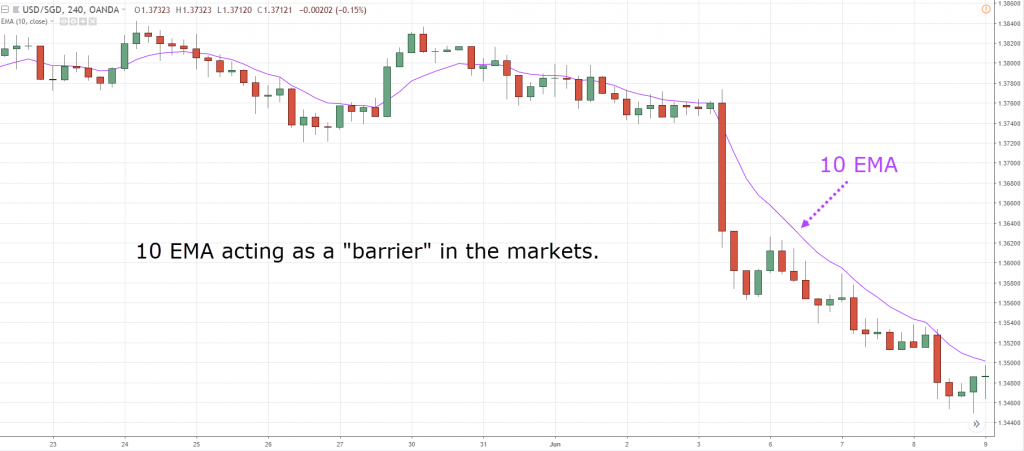
Dynamic support at (SOYBNUSD):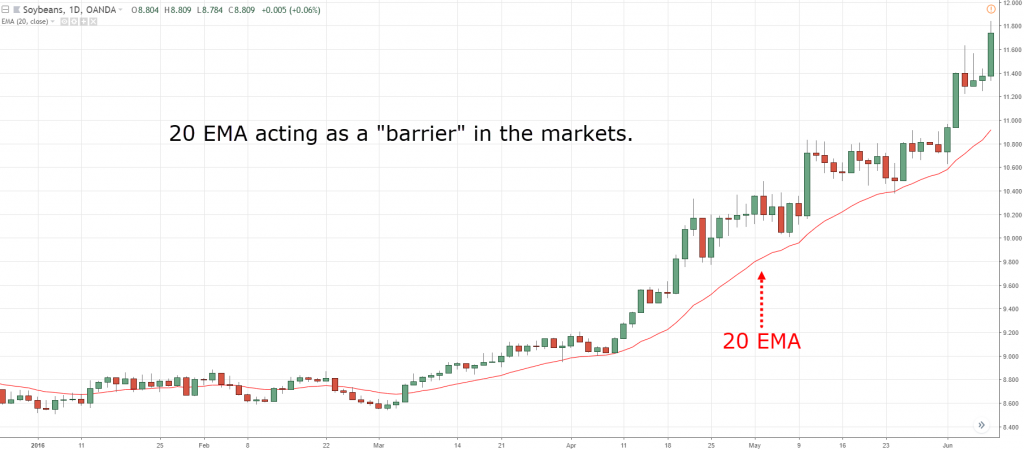
Dynamic support at (DE10YBEUR):
Does it make sense?
Great let’s move on…
How to use the moving average indicator to better time your entries
Now:
What I’m about to share with you will greatly improve your trading entries.
You’ve learned that in a trending market, MA can act as dynamic Support & Resistance (SR), which is an area of value to trade from.
And, if you haven’t realized…
The market is like a “rubber-band”. It will snap back if it’s stretched too far away from the dynamic SR.
Now you’re probably wondering:
“How does this help with my trading entries?”
Well, think about this.
If the market “overextended”, then chances are it will pull back towards the MA.
Thus, if you’re looking to enter your trades, you’ll probably get stopped out as the market retraces against you.
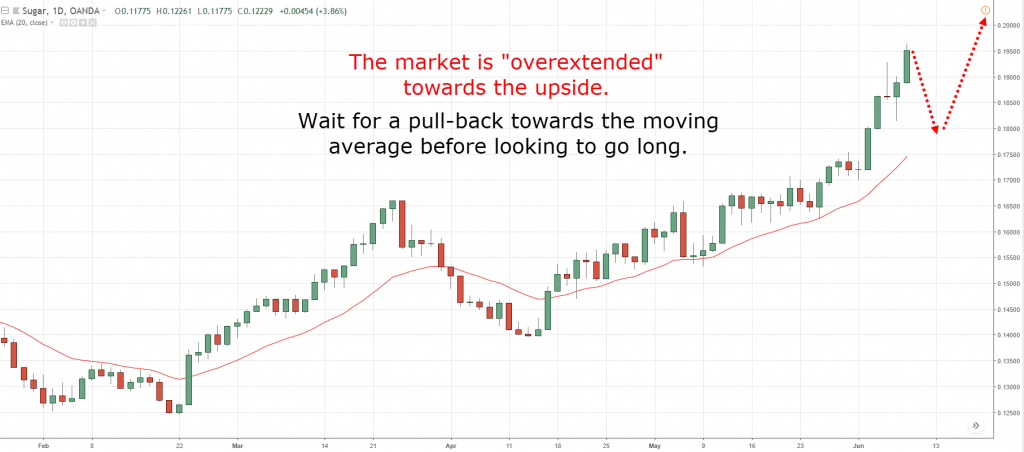
So…
If you want to better time your entries, look to enter your trades at an area of value (like dynamic SR), and not when it’s far from the MA.
Makes sense, right?
Exercise:
Look at your past trades and notice how many of your losers are derived from trading far away from the MA.
You’d be surprised at your findings.
How to use moving average indicator to ride massive trends
Let me tell you a secret.
The only way for you to ride a trend is to have no profit targets. Why?
Think about this… if you have a profit target, what you’re doing is putting a limit on your profits.
And, how are you going to ride a trend if you limit your profits?
Now… I’m not saying having a profit target is wrong because swing traders do fine with a fixed profit target.
But if you want to ride a trend, then having a profit target is contradicting.
Now you’re probably thinking:
“Okay, Rayner. I understand I cannot have a profit target if I want to ride a trend. So, how to read moving average to ride the trend then?”
Simple.
By trailing your stop loss. And the MA indicator allows you to do just that.
Also…
You’re probably aware that in a trending market, MA can act as dynamic SR.
And once in a while, it can be respected by the markets for a long period of time (and I mean really long).
Here are a few examples…
Riding the rally at (DE10YBEUR):
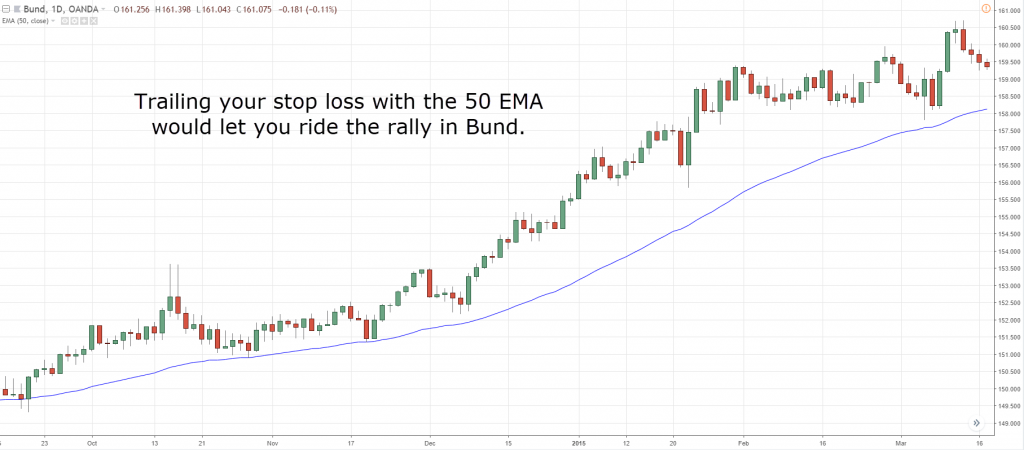
Riding the rally at (USD/ZAR):
Riding the sell-off at (BCOUSD):
Pro Tip:
The parameter of your MA will dictate the type of trends you’ll capture.
A short-term MA (like 5 EMA) will let you ride short-term trends. Whereas a long-term MA (like 200 EMA) will let you ride long-term trends.
How to use the moving average to identify the best markets to trade
Imagine…
You’re going to compete in a drag race, with a top prize of $100,000.
You’ve got two choices of cars. Bugatti Veyron or Toyota Vios.
Which will you pick?
You’re obviously going to select the Bugatti Veyron, right?
It has more horsepower, it’s faster, and with a better braking system.
Now you’re probably wondering:
“What does it have to do with trading?”
Well, it’s the same.
If you want to long, you’d want to long the strongest market. And if you want to go short, you’d want to short the weakest market.
This allows you to pick the best market and have a higher probability of the trade working out.
So, how do you pick the best market?
By using a concept called, relative strength.
There are various methods to determine relative strength. But one of the easiest ways is to use MA.
Here’s my 3 step process…
Step 1: Pick the markets which are within the same sector.
If you’re looking at indices, then compare markets like S&P, Nasdaq, Dow etc.
If you’re looking at USD, then compare currency pairs like AUD/USD, NZD/USD, USD/CAD, USD/JPY, EUR/USD etc.
Step 2: Plot the 20 & 50 EMA on your charts.
Step 3: Compare the steepness of the MA. The steeper it is, the stronger/weaker the market
In this example, let’s compare the relative strength between USD/CAD and USD/JPY:
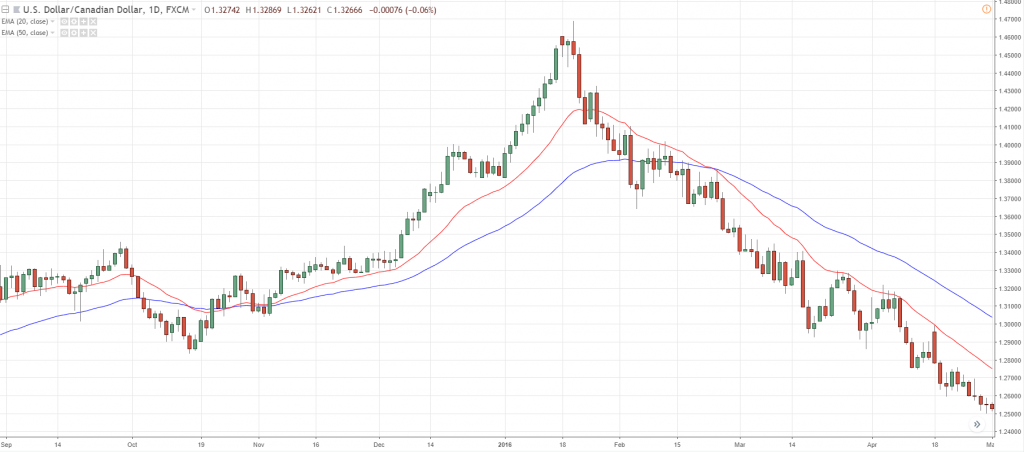

For USD/CAD, the MAs are steep and clearly pointing downwards at the moment.
So you want to be shorting USD/CAD instead of USD/JPY (because it’s a relatively weaker market).
This is powerful stuff, right?
Let’s move on…
A moving average trading strategy that lets you capture big trends
This is not an MA crossover strategy.
Instead…
You’re going to use the MA indicator to identify areas of value on your chart.
Then you’ll get an entry into an existing trend and ride it for all it’s worth.
Sounds good?
Here are 7 questions you need to ask yourself:
- Which time frame are you trading
- How much are you risking on each trade
- Which markets are you trading
- What are the conditions of your trading strategy
- Where will you enter
- Where will you exit if you’re wrong
- Where will you exit if you’re right
Timeframe
You must choose a time frame that suits your personality and schedule.
If you’re someone who holds a day job, trading the 4 hour and daily charts would be suitable.
Risk management
You must risk a fraction of your equity on each trade to survive the inherent drawdowns. Keep your risk to no more than 1% of your trading account.
Markets universe
You should be able to trade about 60 markets from these 5 sectors.
- Agriculture commodities
- Currencies
- Equities
- Rates
- Non-Agriculture Commodities
Here’s the exact moving average trading strategy you can use…
If 200 EMA is pointing higher and the price is above it, then it’s an uptrend (trading conditions).
If it’s an uptrend, then wait for “two test” at the dynamic support (using 20 & 50-period MA).
If price test dynamic support twice, then go long on the third test (your entry).
If long, then place a stop loss of 2 ATR from your entry (your exit if you’re wrong).
If the price goes in your favor, then take profits when candle close beyond 50 EMA (your exit if you’re right).
Vice versa for a downtrend
Here are a few moving average trading strategy examples…
A winning trade set-up at (XAU/USD):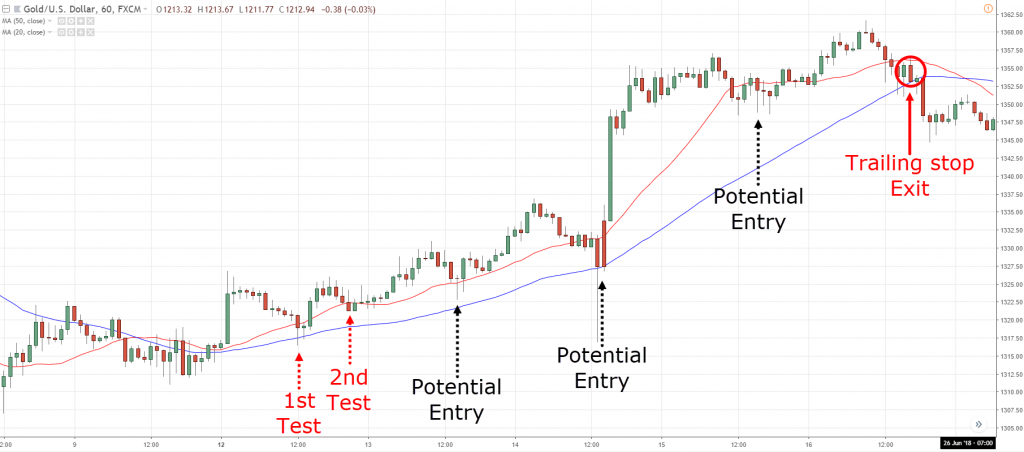
A winning trade set-up at (BCOUSD):
A losing trade set-up at (AUD/USD):
Some important considerations to ask yourself:
- Do you wait for price “confirmation” before entry?
- What markets are you trading?
- Which timeframes are you trading?
- How much will you risk on each trade?
There are no hard and fast rules for this trading strategy.
Instead, you’ll tweak the MA trading strategy according to your own personality and time commitment.
If you want to learn more Moving Average SECRETS, then check out this video here:
Frequently asked questions
#1: Hey Rayner, I see that you’re always using EMAs. But is EMA or SMA better for trend trading?
To be honest, there’s no best type of moving average to use. EMA is simply more responsive compared to SMA, because of the way the EMA is calculated.
But in the grand scheme of things, the concept is what matters more and not whether you should use EMA, SMA, WMA, etc.
#2: When you use the space between 20 & 50EMA to define the area of value, do you use that space to signal that the trend is going to continue? Or do you use that space to signal a change in trend?
The space between the 20 and 50EMA is to define an area of value, I don’t use it to determine if the trend is coming to an end or not.
But what’s for sure is this:
- If the two MAs start to converge, the market is going through a pullback
- If the two MAs start to diverge, it’s when the trend is continuing
#3: Can you elaborate on what you consider as short term, medium term and long term trend?
How the price respects the moving average is useful to help you define the type of trend (whether it’s a strong, healthy or weak trend).
But whether you consider a trend to be a short term, medium term or long term trend, will depend on your timeframe:
- For short term trends, you can look at timeframes below the 1-hour timeframe
- For short to medium term trends, you can look at the 1-hour to 4-hour timeframe
- For medium term trends, you can look at the 4-hour to daily timeframe
- For long term trends, you can look at any timeframe above the daily timeframe
#4: Should I change the MA’s period according to the timeframe I am trading on?
It’s not necessary. I’ll usually have 3 different moving averages to define the 3 types of trends:
- 20MA to identify strong trends
- 50MA to identify healthy trends
- 200MA to identify weak trends
So even when you change the timeframe, you can use those 3 moving averages to identify the type of trend the market is exhibiting. If the market respects none of the above moving averages, then you can just remove those moving averages.
If you want to discover more on how to read moving average and learn about different types of trends to level up your trend trading game, you can read all about them here.
To recap, here’s what you’ve learned today…
The Moving Average indicator helps you:
- Identify the path of least resistance
- Identify areas of value on your chart
- Set your stop loss
- Better time your entries
- Ride massive trends
- Pick the best markets to trade
I hope this opens your eyes to how powerful MA can be, and you’ve managed to pick up a thing or two along the way.
Now here’s the next step…


